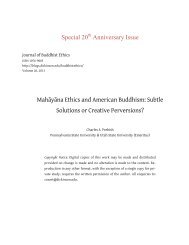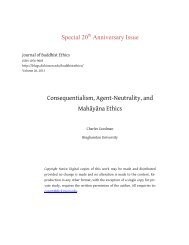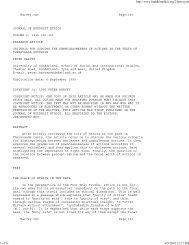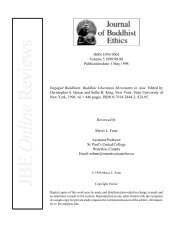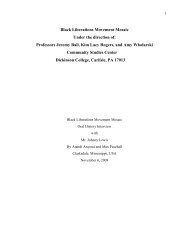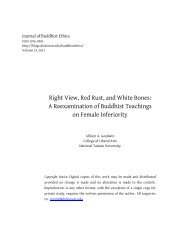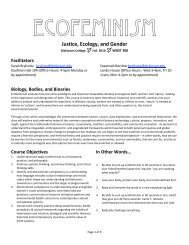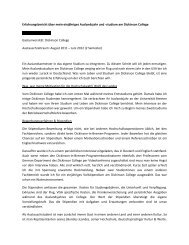Unmistaken Child - Dickinson Blogs
Unmistaken Child - Dickinson Blogs
Unmistaken Child - Dickinson Blogs
You also want an ePaper? Increase the reach of your titles
YUMPU automatically turns print PDFs into web optimized ePapers that Google loves.
Journal of Buddhist Ethics<br />
ISSN 1076-9005<br />
http://blogs.dickinson.edu/buddhistethics<br />
Volume 19, 2012<br />
<strong>Unmistaken</strong> <strong>Child</strong><br />
Reviewed by Jason Ellsworth<br />
jwmellsworth@yahoo.com<br />
Copyright Notice: Digital copies of this work may be made and<br />
distributed provided no change is made and no alteration is<br />
made to the content. Reproduction in any other format, with<br />
the exception of a single copy for private study, requires the<br />
written permission of the author. All enquiries to:<br />
cozort@dickinson.edu
A Review of <strong>Unmistaken</strong> <strong>Child</strong><br />
Jason Ellsworth 1<br />
<strong>Unmistaken</strong> <strong>Child</strong>. DVD. Directed by Nati Baratz. New York, NY:<br />
Oscilloscope Pictures 2009.<br />
It has been twenty years since the release of Ritu Sarin and Tenzing<br />
Sonam’s The Reincarnation of Khensur Rinpoche (1991), the documentary<br />
film that inspired both Bernardo Bertolucci’s Little Buddha (1993) and<br />
Martin Scorsese’s Kundun (1997). While today the politics surrounding<br />
the Dalai Lama and Tibet’s freedom continue to garner most of the<br />
spotlight on the world stage, Israeli director Nati Baratz, has created a<br />
film that reminds us of the enduring bond between master and student<br />
within Tibetan Buddhism. <strong>Unmistaken</strong> <strong>Child</strong> is not simply a story of<br />
reincarnation. The film chronicles death, bereavement, and one person’s<br />
struggle to find meaning when the ties of religious devotion become<br />
strained.<br />
The film documents Tenzin Zopa on his search for the<br />
reincarnation of his late master, Geshe Lama Konchog, who passed away<br />
in 2001 at the age of 84. Zopa, a disciple of Lama Konchog since the age of<br />
seven, finds himself alone and filled with the anxiety that his charge, to<br />
find his master’s reincarnation, will not be realized. Packing Lama<br />
Kochog’s prayer beads and other belongings, which will help locate and<br />
identify the lost master, Zopa heads out on a journey that takes him<br />
through the villages, mountains and valleys of Tibet and Nepal. Zopa is<br />
led forward, discerning signs from patterns in a cremation pyre,<br />
observing the drift of cremation smoke, divining with relics, and<br />
following the advice of an astrologer from the Heruka Centre in Taiwan.<br />
1 Email: jwmellsworth@yahoo.com
Ellsworth, Review of <strong>Unmistaken</strong> <strong>Child</strong><br />
He travels by foot, mule and even helicopter, traversing the Nepalese<br />
landscape of the remote Himalayas leading to the Tsum Valley where the<br />
master has supposedly returned (a place of significance to both Zopa and<br />
Lama Konchog).<br />
Finding a boy in the Tsum Valley who has an affinity for Lama<br />
Konchog’s prayer beads and regularly waters an apple tree that the lama<br />
himself once planted, Zopa believes he may have found his master’s<br />
incarnation. Here the film introduces us to a small child, raised in rural<br />
community and depicts his accent through the intricate complex of the<br />
monastic world. Baratz explained in an interview with PBS that the story<br />
is not so much about the phenomena of reincarnation.<br />
For me, the story is less about reincarnation than about<br />
Tenzin and his amazing story of maturation. For 21 years,<br />
the young monk never left his master’s side. During the<br />
movie, Tenzin goes from servant to spiritual leader,<br />
eventually bringing the treasure back to the Tibetans.<br />
(“<strong>Unmistaken</strong>”)<br />
Murray Smith’s theories on character engagement explain well what<br />
Baratz attempts to convey. Specifically, two elements of Smith’s theory<br />
explain how film creates a viewpoint from where the observer becomes<br />
aligned with specific characters. First, an allegiance is built between the<br />
viewer and the characters onscreen. Next, through this allegiance, the<br />
viewer constructs an intricate network of emotional ties to the film’s<br />
characters, plotlines, and to the abstract concept of the film itself.<br />
Smith’s theory helps us understand the importance of Baratz’s vision,<br />
which shapes the emotional direction of the film and explains the<br />
visceral impact of the work.<br />
In <strong>Unmistaken</strong> <strong>Child</strong>, the viewer is drawn in and aligned with Zopa<br />
and it is here that our sympathies and allegiances lie. While the student<br />
teacher relationship is central to the plot, Zopa is the central focus of the<br />
film. In him we find a man who is obedient to his elders and<br />
638
639<br />
Journal of Buddhist Ethics<br />
demonstrates unflagging emotional strength in the face of<br />
overwhelming grief. Yet behind closed doors, and luckily for us on the<br />
screen, a deeper narrative unfolds. In these cloistered spaces we witness<br />
a desperate monk who breaks down crying while in his master’s retreat.<br />
We see Zopa as a man who displays incredible humility, believing that he<br />
does not have the power to take on the monumental endeavours he<br />
faces. The sincerity and richness of character, which Zopa exhibits, draw<br />
viewers inexorably deeper into his life.<br />
While the director “felt that Tenzin is an amazing character, and<br />
that his physical and emotional quest has mythical qualities,”<br />
(“<strong>Unmistaken</strong>”) one cannot ignore the social aspects and social<br />
structures surrounding death that come through in the master-student<br />
relationship in this film. In his studies on death, Clive Seale observes:<br />
Maintenance of a human social bond is a fundamental<br />
motive for social participation, reflected both in large-<br />
scale ritual events and the micro-rituals of everyday<br />
interaction, where minor currents of exclusion and<br />
inclusion underlie the smallest conversational exchange,<br />
generating feelings of pride and shame in the flux and<br />
flow of membership negotiations. (2)<br />
Throughout this film the viewer is exposed to multiple rituals including<br />
tests to reaffirm the rebirth, the identification of the master’s objects,<br />
various naming ceremonies, and various funerary rites. Through these<br />
rituals the social bonds Seale describes are both reaffirmed and newly<br />
constructed.<br />
While scholars may want to analyse Tibetan Buddhist forms of<br />
ritual praxis, theories on death and rebirth, or approaches to<br />
bereavement and character development within a documentary such as<br />
this, another area ripe for discourse is the post-documentary life of<br />
monks in film. For example, blogs have become a common form of<br />
expressing oneself online and shortly before the release of the film, two
Ellsworth, Review of <strong>Unmistaken</strong> <strong>Child</strong><br />
were created, one for Zopa (http://www.geshezopa.blogspot.com) and<br />
one for Tenzin Phuntsok (http://phuntsokrinpoche.blogspot.com). The<br />
film appears to have been highly effective in creating a stage for these<br />
monks that will carry their activities and message through the online<br />
blogosphere. A search into the effects that documentaries have on those<br />
being filmed or how they live their lives in Tibet after the production of<br />
such documentaries may be a point of interest for scholars in the future.<br />
References<br />
Seale, Clive. Constructing Death: The Sociology of Dying and Bereavement. New<br />
York: Cambridge University Press, 1998.<br />
Smith, Murray. Engaging Characters: Fiction, Emotion, and the Cinema.<br />
Oxford: Clarendon Press, 1995.<br />
“<strong>Unmistaken</strong> <strong>Child</strong>.” [i]ndependent Lens. Independent Television<br />
Services. Accessed: 25 October 2011 (http://www.pbs.org/<br />
independentlens/unmistaken-child/makingof.html).<br />
640



